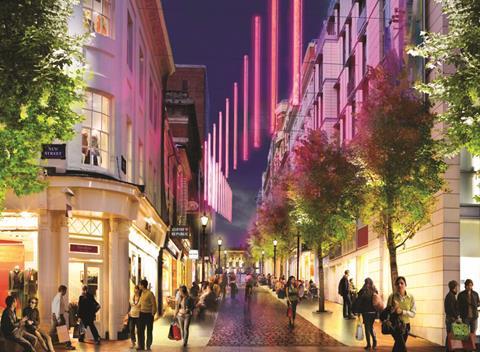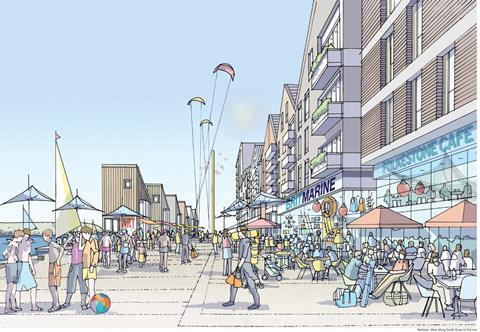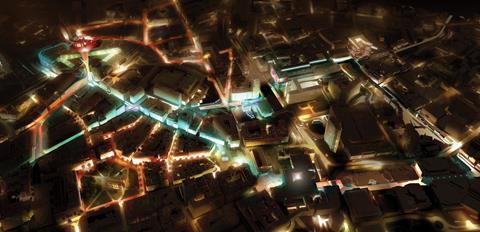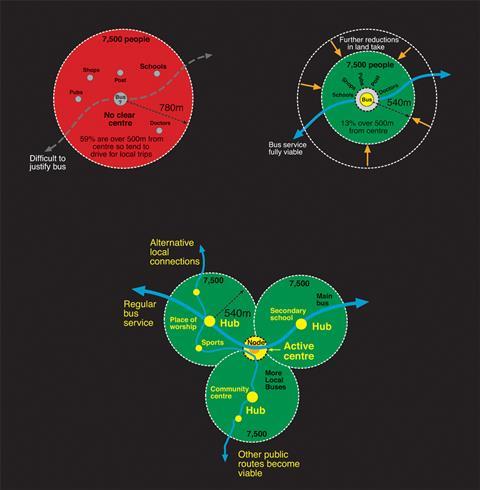With one in seven shops now boarded up in BritainŌĆÖs town centres, four leading architects suggest ways to revive the high street


The high street has hit a new low. One in seven retail units across 650 British town centres now stand empty, according to figures from retail information provider the Local Data Company (LDC). ThatŌĆÖs 24,000 shops. A malaise that began with the rise of online shopping and out-of-town supermarkets, but was partly obscured by the pre-recession tendency for consumers to spend beyond their means, has been cruelly exposed by five years of economic turmoil.
The high streetŌĆÖs woes pose a major challenge not just to retail businesses, but also to communities, and to the very idea of towns and cities as socially sustainable places. ŌĆ£Town centres are changing fundamentally and itŌĆÖs imperative that they remain connected with the community,ŌĆØ says Matthew Hopkinson, director of the LDC. ŌĆ£If this is not achieved, town centres will become playgrounds for crime and social unrest.ŌĆØ
This is a point echoed by Ken Shuttleworth, the founding partner of Make and one of four leading British architects who, over the next three pages, share their thoughts on the future of the high street. ŌĆ£I think some high streets across Britain will get worse and could eventually become ŌĆśno-go areasŌĆÖ,ŌĆØ he says.
So far, the governmentŌĆÖs response to this threat has been to commission retail consultant Mary Portas to suggest ways of saving the ailing high street. In December last year, Portas published a review, listing 28 recommendations. Of these, her suggestions of creating ŌĆ£Town TeamsŌĆØ, an operational management team for high streets, has been well received, together with her call for a number of high street pilots
to be set up to rejuvenate shopping areas.
To date, the government has announced funding for pilot projects in 24 towns, with a further three being funded by the Greater London Authority. But if the challenge facing the high street is so fundamental - particularly with the rise of online shopping - perhaps the answers need to be more radical. Do we need to reimagine our town centres altogether? Here, architects Richard Rogers, Terry Farrell, Ken Shuttleworth and David Kohn talk exclusively about the issues facing BritainŌĆÖs high streets and how to deal with them.
Ken Shuttleworth founding partner, Make

The problem with the high street in many town centres is that its character has disappeared. Shops have often done their own thing and the public realm is falling apart. Architects have a role to play in revitalising the high street by designing better signage, lighting, litter bins, paving and seating. You just need to look at Kensington High Street and the public realm work there. Now people want to visit and enjoy the experience of walking along it.
I shop a lot in Marylebone High Street, which is a fantastic example of a well-designed high street with lots of character. It still allows traffic but the cars move more slowly and you donŌĆÖt feel like youŌĆÖre about to be hit when you cross the road.
We have just done a Retail Birmingham Design Strategy for the city and we found there that people get stuck and stay in one area and donŌĆÖt walk further afield, mainly because there is no route and the spaces are cluttered. In our design strategy we have identified the main routes to entice people to other parts of the shopping area.
I think some high streets across Britain will get worse and could eventually become ŌĆ£no-go areasŌĆØ. The reason for this is because these high streets are located in towns where there is no local authority leadership and a reluctance to do anything. Money should be allocated to a high street fund and ring-fenced.
Getting local authorities and shopkeepers to work in partnership to sort out the total high street experience is what weŌĆÖve done for Birmingham and is the way forward. If properly thought through, improvements to the public realm bring out the character of the high street, and out-of-town shopping centres canŌĆÖt compete with that.
ŌĆ£Improvements to the public realm bring out the character of the high streetŌĆØ
Terry Farrell, principal, Farrells

IŌĆÖm not sure I see the high street as a problem. It sounds like a sick friend and I donŌĆÖt regard the high street as sick. It just has continuing issues. [Town planner] Colin Buchanan warned of the problem with the motor car in BritainŌĆÖs towns and cities in the 1960s and in the 19th century there were problems with the amount of horse droppings in high streets.
The British high street is now in transition. People wonŌĆÖt go there for shopping as much as before, but it offers other kinds of activities and is still thecentre of community life. High streets have been and always will be at the centre of British urbanism.
We are involved in lots of high street projects. They either involve high streets that have disappeared altogether like Vauxhall Nine Elms and we have to rediscover where the high street used to be. Or they involve high streets that faded, like the regeneration in Folkestone. Then there are projects where we are creating new high streets, like the Earls Court redevelopment.
When designing a new high street we are creating buildings with a ground, first and sometimes basement floor that are highly flexible and respond quickly to phases of ownership. There is a great turnover now with high streets and to facilitate that we have pop-ups or long-term pop-ups and the space is managed.
I think shops will reinvent themselves as places of spectacle, entertainment and leisure. The public realm is hugely critical to the success of a high street but design is just one component, like a bead on a necklace. High streets shouldnŌĆÖt be
over-designed, it wonŌĆÖt work. High streets need spontaneity and a creative churn. What architects contribute is very important but they are not the maestros, they are a part player.
ŌĆ£shops will reinvent themselves as places of spectacle, entertainment and leisureŌĆØ


Richard Rogers, chairman, Rogers Stirk Harbour + Partners

The only sustainable form of development is the compact city. You could have a beautiful eco-house in the country but it still uses more energy than a clapped out old house in the city. The reason is that you have to go by car. High streets are at the heart of our city and they are being killed off by out-of-town shopping developments.
The Urban Task Force recommended 13 years ago that we shouldnŌĆÖt build out-of-town shopping centres and that the high street shouldnŌĆÖt be undermined. Now there is a more laissez-faire view from the government who want to open the door to shopping centres, where things are cheaper and subsidised with free parking, and this leads to the town and high street being run down.
Public policies which encourage developers to build on urban brownfield sites first, to retrofit existing buildings, and which put a green belt around compact, polycentric cities, must be supported (see diagram, left). Careful planning is about establishing a balance and the right mix of live-work and leisure facilities, with people not living too far away from existing facilities. This would limit the use of cars and discourage suburbia, which is very inefficient.
ŌĆ£High streets are at the heart of our city and they are being killed off by out-of-town developmentsŌĆØ
David Kohn, director, David Kohn Architects

We are working on two high street projects in greater London - one in Hounslow and one in Harrow. They were both pedestrianised in the past and are experiencing similar problems. They have either shopping centres or supermarkets located outside but near to the high street and, in the case of Harrow, the high street is like a vestigial organ that is no longer used.
The decision to pedestrianise the high streets was all about removing traffic, and the pedestrianŌĆÖs experience was not properly considered. The pedestrianised street wasnŌĆÖt seen as a public space and was not designed to be busy and rich.
If we can help local authorities, communities, shopkeepers and other stakeholders by providing an infrastructure, the high street in its entirety will become the place to be and people will want to spend time there. Shopping centres see the space between shops as active and offer more than just the shopping experience, while in the high street people just want to get from A to B. There is no reason why high streets canŌĆÖt offer more but they have to be conceived in this way.
The high street does have a future, but rather than repaving it and making it look tidier, it can also be made suitable for a 24/7 busy public life. I donŌĆÖt see the point in making a beautiful granite street if nobody uses it. Why not think about how we could programme the space for 15 years to keep it busy and a delight - like an event space? It could be used for public events that change from night to day, from weekdays to weekends, from season to season. This might range from food markets to music festivals, from temporary architectural installations to dance classes, Diwali and Christmas celebrations, or from airplane spotting (in Hounslow) to repair workshops. High streets are usually easy to reach, with good transport connections, open to everyone and free to enter - and you can do some shopping there too.
ŌĆ£I donŌĆÖt see the point in making a beautiful granite street if nobody uses itŌĆØ
MORE AT ECOBUILD
Reinventing the High Street

Tuesday 5 March, 14.45-15.45





























No comments yet